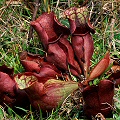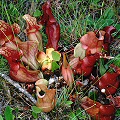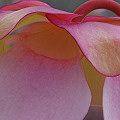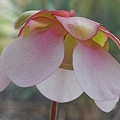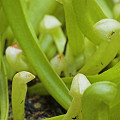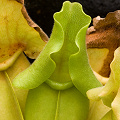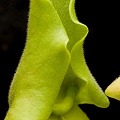Q: About Sarracenia rosea, Burk's pitcher plant
A: Sarracenia rosea is a short pitcher plant that looks very much
like Sarracenia purpurea. In fact, until very recently it was considered merely a variety of that
species, and its being described as a separate species has been a matter of contention indeed!
Those interested in the differences should refer to the original papers, but as a summary the
key distinguishing characters are given below.
1)The pitcher characteristics of S. rosea are somewhat different
(larger hood, big lip, etc.) than those of S. purpurea. For example, the lip is thicker
for S. rosea
(2.6-7.5 mm) than for S. purpurea (0.7-3.1 mm). The lip character has been shown, in subsequent papers,
to be particularly reliable.
2)Sarracenia rosea is the only Sarracenia with pink petals
(except for some hybrids). The petals of S. purpurea are brick red to purplish red.
3)The flowers of S. rosea are larger (petals 4.5-6.4 cm long), and are on shorter peduncles (16-35 cm), than you see in
Sarracenia purpurea (petals 2.2-5.3 cm; peduncles 22-79 cm).
Sarracenia rosea is very easily grown in terraria, and is an ideal plant for first-time
growers. I think it is probably the easiest of all Sarracenia to grow.
Sarracenia rosea
plants from the Chipola (Florida) area are particularly cute, and often have fat little pot bellies.
Range
States: Georgia, Florida, Alabama, Mississippi. (Louisiana records are probably incorrect.)
More detailed range information for its states are as follows--Georgia (Lee, Randolph, and Tift Counties);
Florida (throughout the western pandhandle counties all the way east to around Gadsden County); southern Alabama; and
southern Mississippi (George, Harrison, and Jackson Counties). Reports for it in Louisiana (St. Tammany Parish) are
based on two old (1871) herbarium specimens that are quite possibly mislabelled. It has been eliminated from the
three Georgia counties---the final populations in Randolph County were destroyed by 1960. There
is some speculation that it may occur (or may have once occurred?) in Taylor County (Georgia).
There is an anthocyanin-free form of S. rosea, called
S. rosea f. luteola. In Gulf County (Florida), plants have been
detected that are "veinless" and "semi-veinless"; terminology I describe more on the
FAQ page on S. purpurea.
In the wild, this species has a fairly wide range but the range is in a part of the USA where development is
occurring at great rates. Some sites have a certain degree of protection, so it is unlikely the species will go extinct in the
wild in the near future, but we will see the great majority of the sites eventually destroyed. It may already have
been extirpated in Georgia.
The controversy of its species status
Botanists are not at all in agreement about whether this plant should be given separate species status. You should decide for
yourself. To be more informed, here is a history of the plant's name.
This plant has long been known to horticulturists because of its vigor and pretty pink flowers. Wherry was the
first to give it a name, and in 1933 he informally dubbed it with the horticultural name of "Louis Burk form", who, as far as
I know, was not related to my college girlfriend, who had the same last name and who probably still despises me.
As a nod to its nomenclatural heritage, I have coined the common name "Burk's pitcher plant" for this species.
Its Latin name notes the pink flowers; a unique characteristic in the genus, except for hybrids.
Later, in 1993, when Don Schnell realized that this plant occurred frequently in the wild and was actually the only form of
"S. purpurea" that occurred in the Gulf Coast, he gave it the name
S. purpurea subsp. venosa var. burkii.
I wonder why Schnell did not assign this plant the rank of subspecies, since it has a separate range and is clearly
different in floral and pitcher characters? I will have to ask him some time.
Anyway, there things stood until Naczi et al. decided in 1999 that this plant was so different from
the other plants in the genus that it should be considered a separate species:
hence Sarracenia rosea. Subsequent allozyme analysis
(a biochemical genetic technique) by other researchers suggests not only that
Sarracenia purpurea subsp. purpurea and
Sarracenia purpurea subsp. venosa are closely related to each other,
but that they are also more closely related to each
other than they are related to S. rosea. This supports the concept of the name
Sarracenia rosea.
Recent research by Aaron Ellison and his team is providing yet more support for this genetic argument with observations
on the different habitat conditions for the different entities. Their research supports that the separation of
S. rosea and S. purpurea should be maintained. I
do not wish to sound sycophantic, but I consider Ellison's pronouncements to carry considerable weight.
On the other hand, in 2002 Schnell reiterated his perspective that he certainly does not believe that S. rosea
should be considered a distinct species. He continues to maintain this stance, as eloquently voiced in
McPherson & Schnell (2011).
Here are the differences between my perspectives, and those of Don Schnell:
- Method #1--as per McPherson & Schnell (2011)
- Sarracenia purpurea L.
-
-
- S. purpurea subsp. purpurea f. heterophylla (Eaton) Fern.
-
- S. purpurea subsp. venosa (Raf.) Wherry
-
- S. purpurea subsp. venosa f. pallidiflora S.McPherson & D.E.Schnell
- S. purpurea subsp. venosa var. montana D.E.Schnell & Determann
- S. purpurea subsp. venosa var. burkii D.E.Schnell
- S. purpurea subsp. venosa var. burkii f. luteola Hanrahan & Miller
-
-
- Method #2--as per me
- Sarracenia purpurea L.
-
-
- S. purpurea subsp. purpurea f. heterophylla (Eaton) Fern.
-
- S. purpurea subsp. venosa (Raf.) Wherry
-
- S. purpurea subsp. venosa f. pallidiflora S.McPherson & D.E.Schnell
- S. purpurea subsp. venosa var. montana D.E.Schnell & Determann
-
-
- Sarracenia rosea Naczi, Case & R.B.Case
-
-
- S. rosea f. luteola (Hanrahan & Miller) Naczi, Case & R.B.Case
-
-
When I first read of the new name "S. rosea," I responded by writing a review in
Carnivorous Plant Newsletter that said (with suitable scientific understatement)
that "it is not at all clear if this status is appropriate." Meanwhile, in this FAQ I wrote (with more candor and
energy) "I think this is drivel....new species? Bah!"
Well, in the intervening years I flipflopped and now accept and use the name. There...I have eaten crow.
By the way, I became convinced the new name probably had merit during my 2005 and 2006 field seasons. During this time
I took trips to see Sarracenia alata in Mississippi-Louisiana and
Texas. While I had thought of S. alata as being fairly constant in form,
and only really varying in pigmentation patterns, I was amazed to see how some plants
mimicked S. flava, S. oreophila, S. alabamensis
subsp. wherryi, and S. alabamensis subsp. alabamensis. My epiphany
was that the apparent morphological gulf between these species is not as great as I had thought, and suddenly it seemed that the
erect pitcher plant species were more similar in form than I previously considered. As a result, the differences between
S. rosea and S. purpurea became more pronounced. If you do not follow me,
it does not really matter!
Page citations: Ellison, A.M. et al. 2004;
Godt, M.J.W. & Hamrick, J.L. 1999; Kartesz, J. et al. 2009 (BONAP);
Mazur, C.J. & Lechtman, J. 2005; McDaniel, S. 1971; McPherson, S. & Schnell, D. 2011;
Naczi, et al. 1999; Rice, B.A. 2006a; Schnell, D.E. 1976, 1993, 2002a;
USDA, NRCS 2007; personal observations.
